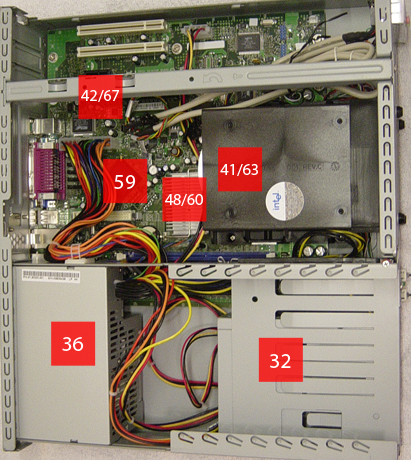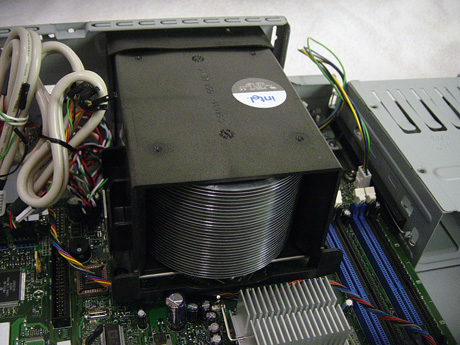Intel's Long Awaited BTX Form Factor
by Purav Sanghani on November 15, 2004 5:31 AM EST- Posted in
- Cases/Cooling/PSUs
Thermals Micro BTX (uBTX)
This is where everything we have heard about the BTX form factor is either proven right or wrong. Intel claims BTX the better design to efficiently cool more components with less equipment while using less power and space. Intel released a virtual press kit on their BTX form factor in April of this year. Unfortunately, the press kit is a little too general to really draw many conclusions, but feel free to judge for yourself.Intel's press kit reports that the BTX design cools the CPU to 2 degrees lower than the ATX form factor while only providing 40 cubic feet per minute, or 40 cfm with our Type I Thermal Module. ATX, on the other hand, requires 150 linear feet per minute, or 150 lfm.
We performed our inch by inch temperature observation with the D915GMH microBTX motherboard and the Pentium 550 CPU in the AOpen B300 which is 15" in width by 13" in depth.

Click to Enlarge
From our results above we see that the temperatures of each square inch of the case are a few degrees higher than those we found on our ATX Ahanix D.Vine 5 chassis. The warmest pocket of air hovers between the PCIe card, Southbridge, Northbridge, and CPU. This area, which averages about 35 degrees, is warmer than the ATX ambient average of about 32 degrees. Intel's whitepaper was not clear on the equipment they used to get the results in their table but from our results, the standard ATX system performs cooler than the BTX system. The microATX system, however, produced temperatures higher than those of the microBTX system.

Click to Enlarge
The results for the core temperatures of each component shown above also tell us that the microBTX equipment does not exactly perform better than the ATX hardware, but for the amount of fans in the system, microBTX is more efficient when it comes to cost of energy and space. With only the CPU's HSF and the power supply's single 80mm fan, the uBTX system performs at temperatures lower than an uATX system with three case fans and a dedicated CPU HSF.

Click to Enlarge
These temperatures are not set in stone for every processor Intel manufacturers or will release in the future. Each will require a different thermal module according to their Thermal Design Power rating. For example, The Pentium 550J will come bundled with a Type I Stacked-fin module whereas the Pentium 560J will come with the Type I Spiral-fin module. Obviously the spiral-fin module will dissipate heat better than the stacked fins.










77 Comments
View All Comments
stephenbrooks - Monday, November 15, 2004 - link
Do you think if you connect the power to the fans the other way around you can get air to flow in from the front and come out of the back instead?SolarWind - Monday, November 15, 2004 - link
Actually, I like how they moved the processor towards the front of the case. This way the processor isn't in the path of hot air rising from the video card.Also, having the video card flipped over means that high performance heat sinks on the video card won't block a PCI/PCI Express slot.
DeeTees - Monday, November 15, 2004 - link
Your right, I would have sworn that I saw that mess inside of a Packard-Bell. At least they have not yet started using custom fasteners that you need a special tool to replace or upgrade components. (?)quanta - Monday, November 15, 2004 - link
BTX may deliver overall cooler temperature per volume of space, but what about all the hot air that was used to cool the CPU? Wouldn't the hot exhaust cook the video card and bridge controller, limiting overclocking potentials? Temperature aside, having air intake in front of the case reduces usable drive spaces that would be used for fan controllers. If I were designing BTX, I would put CPU on top corner, and a curved 'casing' that would route exhaust to top blowhole.PuravSanghani - Monday, November 15, 2004 - link
#42: Actually it us just these micrBTX cases that do not have rear exhausts...so far. We may see case manufacturers employing case fans as soon as BTX becomes a mainstream form factor.At Computex this past year, we did see some companies like Enlight (http://www.anandtech.com/casecooling/showdoc.aspx?... show off some mid tower cases which did have room to add extra case fans. We still have a lot to look forward to concerning the new form factor.
skunkbuster - Monday, November 15, 2004 - link
it would have been nice to have a rear exhaust...bob661 - Monday, November 15, 2004 - link
Man those P4's sure do run hot. 63C WITH the BTX case. My A64 runs at 36C inside the ancient ATX case. I'm still running the OEM CPU cooler and oh about 6 case fans. :-)Cygni - Monday, November 15, 2004 - link
Looks like BTX is going to work out for Dell and HP... but I dont think its going to have much effect for the enthusiast and self built markets. Seems to me that its going to be at its best in mBTX situations, but full BTX seems ho-hum. I guess its just more crap i gotta buy next time i upgrade. BTX mobo, BTX case, DDR2, SATA HD, PCI-Ex video card, new CPU... they really havent left anything for me to KEEP during a P4 to P4 upgrade. Me no likey.vedin - Monday, November 15, 2004 - link
Where am I supposed to put a window and neon light in that case? Hmm?Spinne - Monday, November 15, 2004 - link
I don't see what the problem is with BTX cases. The design layout, atleast for Intel processors makes a lot of sense as far as thermal regulation goes. Channeled airflow on ATX cases is a niche market, and the fact that there are no standards means that you can't be assured of compatibilty across motherboard solutions. You really don't want to have spent money on a new mobo and case only to find that a lousy capacitor prevents you from using channeled airflow. Also, there's no reason why a manufacturer can't place additional fans in a BTX case to cool the case further. Remember, cases are not upgraded as regularly as the actual hardware, so one always has the option of moving to BTX at one's lesuire. I dunno about you guys, but I live in a college dorm, and the smaller my case footprint is, the happier I am, especially if it's a full form-factor case.